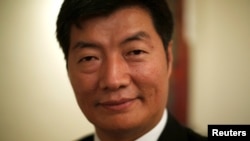The head of the Tibetan government in exile visited the White House on Friday, the first such meeting in 60 years and one that could draw the ire of Beijing.
Lobsang Sangay, president of the Central Tibetan Administration (CTA), said he met with the White House’s newly appointed U.S. special coordinator for Tibetan issues, Robert Destro.
Sangay told VOA he met with representatives from the office of the president and vice president, along with key personnel working on Asia- and China-related issues.
“I was happy and proud to hear that there is a formal recognition and respect for the Tibetan exile administration, our democratically elected leadership, and His Holiness the Dalai Lama’s gift of his political handover to the Central Tibetan Administration,” Sangay said in an interview with VOA’s Tibetan Service.
China seized control over Tibet in 1950 in what it described as a “peaceful liberation” that helped the remote Himalayan region throw off its “feudalist” past. But critics, led by the Dalai Lama, say Beijing’s rule amounts to “cultural genocide.”
Sangay told VOA how it had been his hope and that of the Tibetan people, in the last 60 years since Tibetans have been in exile, to engage with the U.S. government at such a high level. In 1959, the Dalai Lama and thousands of others fled the region, crossing the Himalayan mountains and taking refuge in Dharamshala, India, the current headquarters of the CTA.
Struggle for 'genuine autonomy'
"We discussed the urgency of the Tibet issue, the middle way path and our struggle for meaningful genuine autonomy,” Sangay said. “I expressed my wish for the Tibetan situation to change for the better and my desire for basic freedom for Tibetans in Tibet.”
China’s policies toward Tibet came under a spotlight again this year as ties frayed between Washington and Beijing. U.S. Secretary of State Mike Pompeo told reporters at the State Department in September that the Trump administration was "concerned about Chinese actions in Tibet, in light of the [Chinese] general secretary’s recent calls to 'Sinicize' Tibetan Buddhism and fight ‘splittism’ there," a term referring to groups that deviate from Communist Party of China official policies.
Sinicization is a term China critics use for a process by which the Chinese Communist Party brings traditionally non-Chinese groups under the influence of the ruling Han Chinese.
Sangay noted the U.S. government supports the Tibetan issue.
“Even when the government changes, this support for the Tibetan issue would stay. The message was very clear that there is support from the U.S. president and the vice president’s China and Asia offices on the Tibetan issue,” the CTA president told VOA.
Yeshi Dorje contributed to this report.








